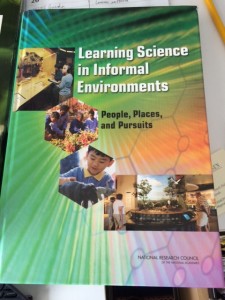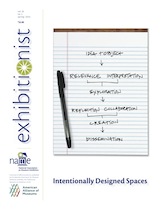Museum Questions Blogger Rebecca Herz and I agreed awhile back to have an open and continuing blog conversation about education and learning in museums. Rebecca has upheld her end of the agreement much better than I. Over the past several months she has posted an interesting question almost every week–on the value of field trips, the kind of learning that takes place in museum settings, the relationships between schools and museums, and many other issues of concern to all who are interested in museums, education, and learning. I’d like to respond to many of the questions Rebecca and her guest bloggers have raised by discussing a publication that has influenced my thinking on museums and learning mainly because it has transformed how I think about what museums are and what exactly is the nature of the experiences that occur there.
In 2009 the National Research Council of the National Academies of Science published Learning Science in Informal Environments: People, Places, and Pursuits, by Philip Bell et al. The book is a compendium and analysis of a generation of research on science learning in informal settings such as science centers, natural history museums, zoos, and similar environments. You can read and/or download the entire book or individual chapters free of charge on the NAS publications website. Among the many insights in this book are two that have changed the way that I look at exhibitions, museums, and learning. See especially Chapter 5, “Science Learning in Designed Settings.”
1. It is not learning or education in museums that is informal. Learning, whether in schools, in the kitchen, or in a museum, is a biological/psychological process of change and insight that can occur in pretty much any setting. It is the environments and methods by which we learn that can be described as formal (classroom, tests, etc) or informal (museums, the natural world, etc). As the authors assess and reflect on the results of many years of museum research, they conclude that what makes science museums different from other informal environments for science learning, like the shore of a pond or a path in the woods, is that museums are informal spaces that have been intentionally designed. Through 3D design, the placement of objects, the creation of activities, decisions on lighting, color, graphic design, audio visual features, etc. science museums intentionally shape visitor experience according to the themes, key ideas, and other concepts and activities that undergird a particular exhibition. The decades of visitor research that the authors analyze has led them to draw some conclusions about what types of design best engage visitors and what the nature of their learning experience is.
2. Rather than specific science content, the authors contend, it is attitudes, approaches, and practices related to science and scientific knowledge that visitors learn in the intentionally designed informal spaces of our science centers, zoos, planetariums, and such. Bell and colleagues have identified six “strands” of science learning that emerge from the research:
– Developing interest in science;
– Understanding scientific knowledge;
– Engaging in scientific reasoning;
– Reflecting on science;
– Engaging in scientific practices;
– Identifying with the scientific enterprise.
Both of these insights–the significance of intentionally designed settings and the description of museum learning in terms of broad strands rather than specific content– can be applied more generally to all museums. The importance of intentional design was recently explored in the Spring 2014 issue of the journal Exhibitionist. That issue will be fully available online later this spring and a couple of articles are available right now at www.name-aam.org.
In 2010, several articles in a special issue of Curator 52:2 on the Bell report took the science strands and examined how they could relate to art (Jessica Luke and Karen Knutson) and history (Mary Alexander). And in the following issue ,Curator 52.3,Beverly Sheppard praised the six learning strands in an article illustrating how they could be applied to all museum disciplines, not just to science learning.
Many of the findings discussed in the Bell report refer primarily to family visits in leisure time. But the authors also discuss research on the efficacy of school field trips, something that Rebecca has discussed at length through guest posts as well as in her own writing. The research shows that the following elements shape the impact of field trips:
– Advance preparation
– Active participation in museum activities
– Involvement by teachers and chaperones
– Reinforcement after the field trip
In her most recent post Rebecca has proposed three experiments that she plans to implement for field trips to the new children’s museum she is heading up. These explorations look like they will help to test out (and no doubt verify) the above four elements.
I don’t see this publication quoted enough in discussions about research on museum learning. I highly recommend the Bell report, the research it examines, and the Curator articles that expand its scope, as a basis for assessing and shaping experiences in the intentionally designed informal spaces (i.e. museums, zoos, botanical gardens, etc) in which we work.
To comment on this article please send a note to me @gretchjenn or to www.museumcommons.com


Gretchen, I too have admired and used the Bell book in my work. I find the 6 strands an invaluable tool for evaluating the educational impact of exhibitions and program. I am going to check out Elizabeth’s blog because I have a feeling that it will resonate with my thoughts on the museum-school relationship. I am disturbed by museum programs’ (and in some cases, exhibitions) conceive themselves as adjuncts to school curriculum. I believe we lose our important status as places of wonder and excitement by linking to formal education’s curriculum with its homework and high stakes tests. Unfortunately, many school districts must justify museum visits by linking them to curriculum. And I agree that the 6 strands can be used to assess learrning in various museum contexts, not just science.
Hi, Ellen, yes absolutely I think there is an even greater trend than ever for museums to see themselves as adjuncts to the school curriculum. AAM emphasizes this in its advocacy efforts with Congress. I wish there were a way to illustrate the importance of museums’ impact as unique places. Yes, check out Rebecca’s blog as she has been raising very interesting and important questions and has had many guest bloggers contribute as well. G